3-day Workshops of “Design Thinking for Your Creative Practice” were held on 24, 30 and 31, October, 2021 and reported by 3 students
Course Group: Leadership, followership and Consensus Building
Course Name: TAL.W502-02 Fundamental Group Work for Leadership I (F)
Program Name: 3-day workshop of “Design Thinking for Your Creative Practice”
Facilitators: Thomas Both and David Janka (d.school, Stanford Univ.), Scott Witthoft (The University of Texas at Austin)
Date & Time: Day 1: 24/Oct/2021 08:30-13:00, Day 2: 30/Oct/2021 08:30-13:00, Day3: 31/Oct/2021 08:30-13:00
The workshop has been reported by 3 students; Tinbete Daniel Alemayehu for Day 1, Nabiel Luthfi Siddiq for Day 2, and Igor Segrovets for Day 3.
<Day 1>
Report by Tinbete Daniel Alemayehu, Department of Architecture and Building Engineering, D2

I saw an announcement on Tokyo Tech website about this workshop, which focuses on exploring design thinking abilities. I wanted to participate in this program and learn from experienced instructors such as Thomas Both, David Janka, and Scott Witthoft. This three-day program has given me much experience within a short period, and it has helped me find time to put my skills into quick action. The workshop was helpful in design thinking ability and research skills. Moreover, it will help you observe your surroundings and how people act in public spaces. I will thus try to explain the activities and contents of the lesson by adding my personal opinion about the workshop.
Pre-day 1: We explored using Mural, a virtual whiteboard space for online workshops. Additionally, we created our avatar and posted it on the Mural grid. We were also told to bring a banana for the next day.
Day 1: Hands-on, creative workout
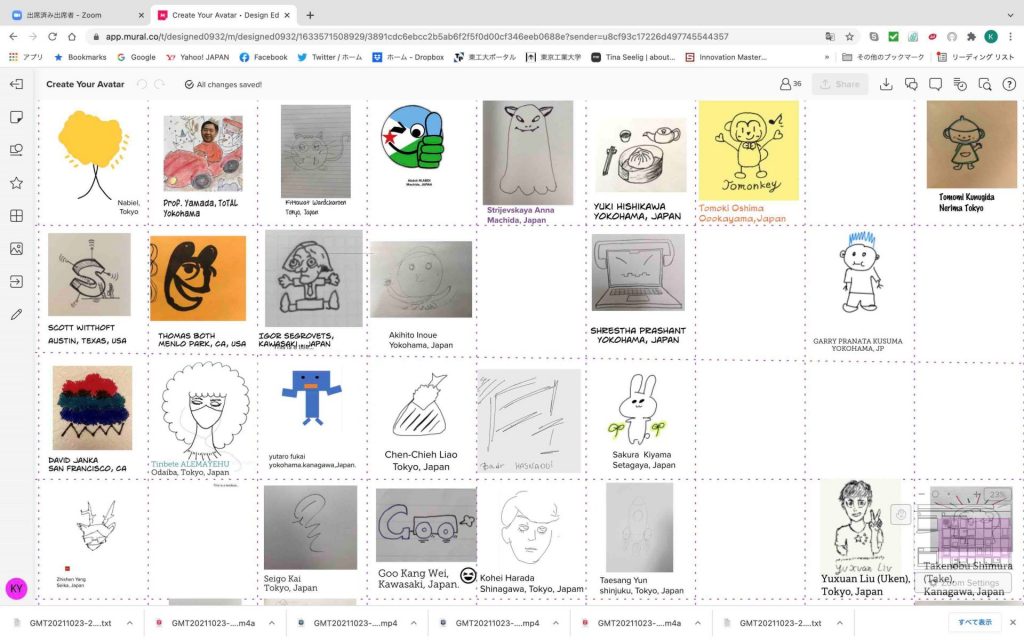
The first day started by introducing our tutors and the act of giving and receiving. The program was held online, so for a start, we picked a person from our zoom 30+ participants to provide a gift to and then gave a virtual gift to our colleagues. The next step was the act of receiving, where we imagined the gift we wanted to receive and wrote it in the chat.
The first part of the workshop was about three major design concepts: design thinking, process, and design skills and methods. The brief introduction focuses on how designers can create, iterate, and focus on people by developing their own sequence or strategies. After the briefing, Scott gave us tips about visual communication while practicing sketching. We need to consider balancing out the details we use on our overall drawings. Next, we sketched 32 different versions of a person using a simple representation. This was one of the design thinking activities within 2 min. I was worried about coming up with 32 possibilities within the given time, but you will be surprised by what you can do when you start sketching. Later on, we selected one of our favorite versions and continued practicing another 32 iterations of the same version. Here, I have learned how creative ideas flow within the given time and draw without going into details.
The next task for the day was to learn how we can create new ideas; it started by making a list of our fascinations and discussing it with other classmates within the zoom breakout room. Our fascinations could be an activity, a thing, a concept, an event, a person, a sub-culture, or anything. After presenting to our classmates, we focused on one of our fascinations and created a print ad to sell bananas; this is the visualization step. We were told to bring a banana beforehand for this task. Additionally, we had to write a slogan for our creative challenge. After taking time off the zoom camera, everyone worked on this task. Within 20 minutes, we had to take a photo of our creative project and upload it online to share our idea. This activity was fun, and I was amazed at the output everyone had. It is exciting to see how one idea can be transformed into visual output, using something edible as a tool. Finally, we had to make a sensible explanation about our project for others to buy a banana.
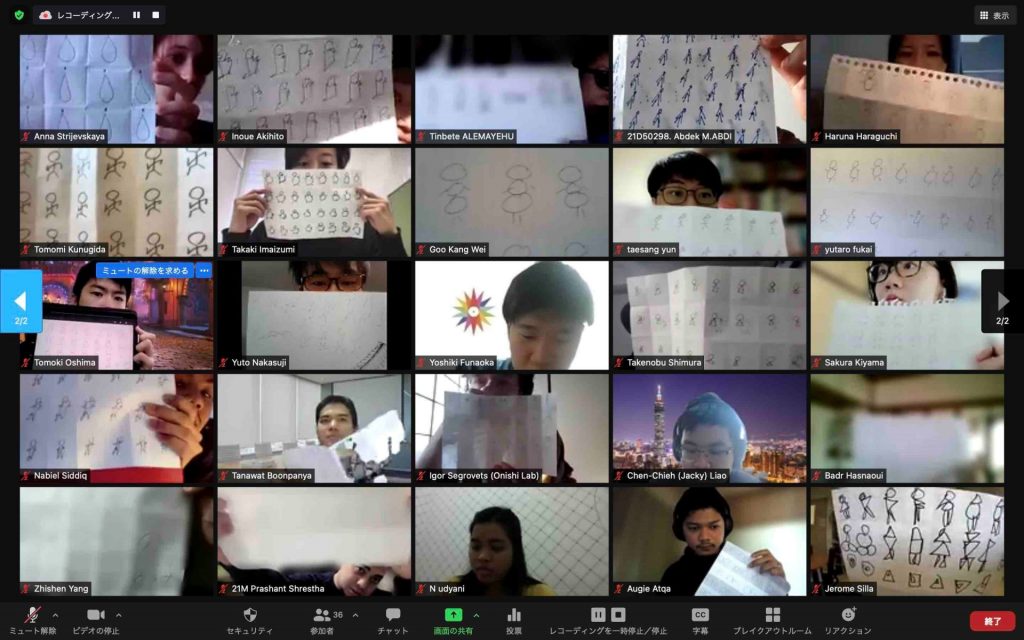
Below are the two ideas that I tried to develop a slogan as “Baha-nana: your yellow to the blue” and “Just go with it.”
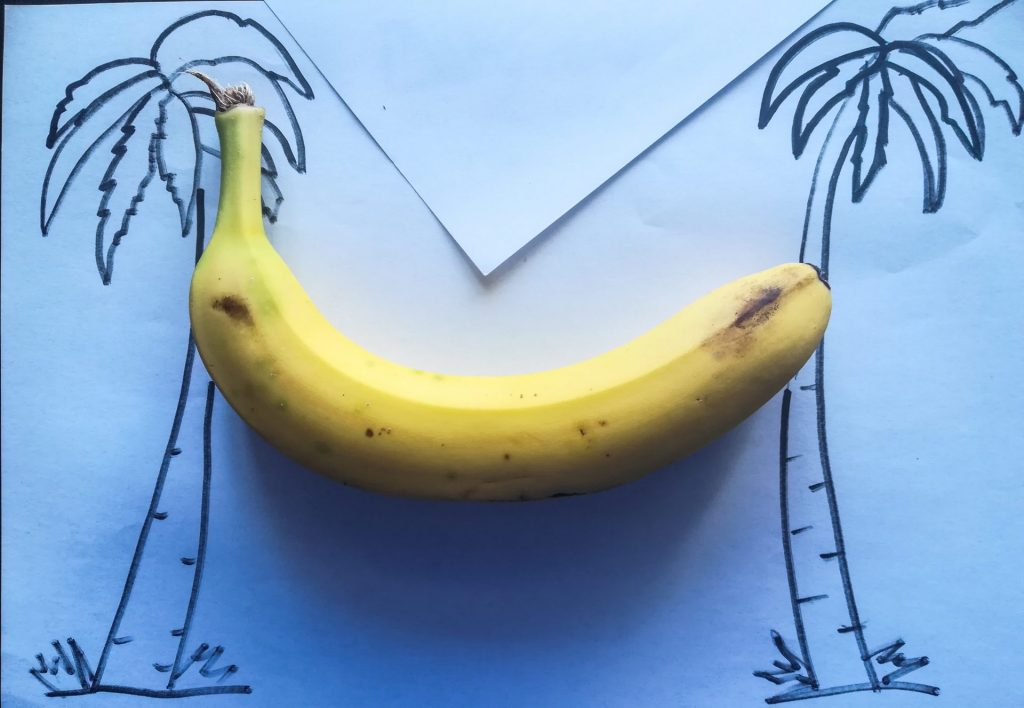
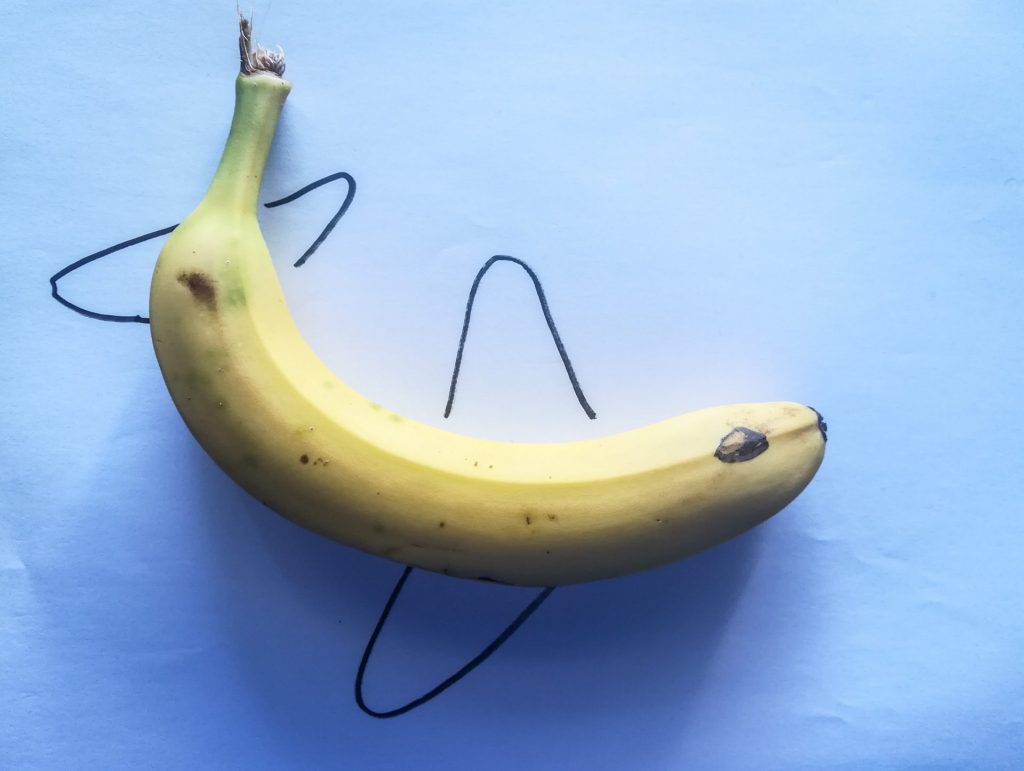
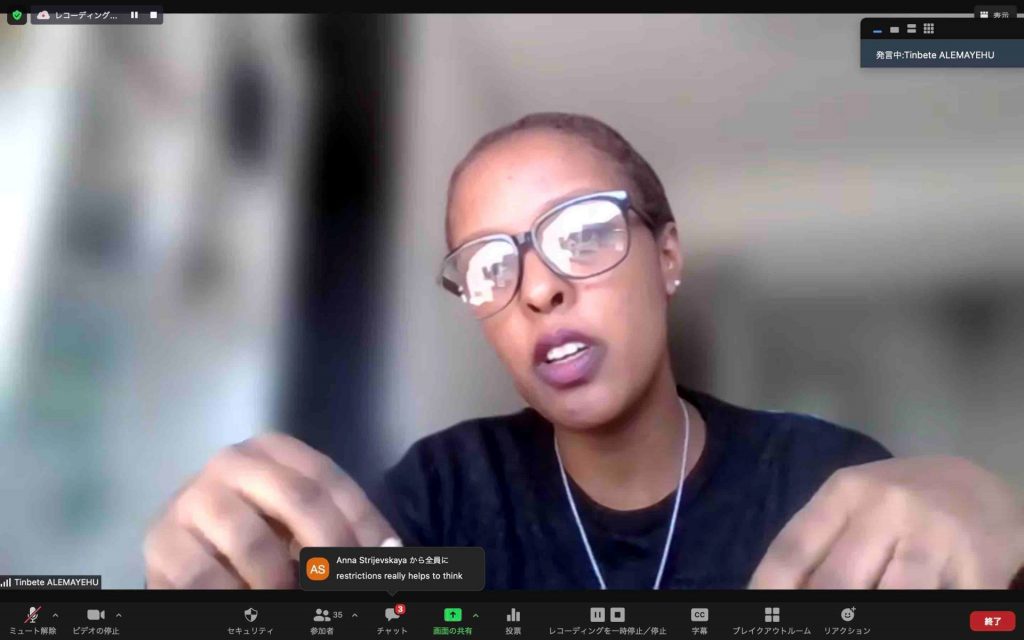
Below are the ideas of my classmates:



The last lesson for Day 1 was to practice noticing and creative habits of keeping a notebook. This session aims to enhance our ability to observe and interpret what we see. We were given a fieldwork assignment between the 1st and 2nd class as a practice. We practiced observation through four frameworks: activities, environment, interaction, objects, and users (AEIOU framework). Furthermore, we had to interpret or make the hypothesis of what we saw by giving reasons for what the person is doing, how they are doing it, or why they are doing it in a certain way.
For the fieldwork, my team selected inside a train, outside a train, or train station areas. I did the fieldwork on two days, one on the weekend and the other on weekdays, to see the contrast between human activities and carrying acts. A practice worksheet was given to us, and we had to take a note, sketch, and record the time. The whole fieldwork took between 40 min to 80 min, for one day. Even before this activity, I observed this situation. However, when logically set and recorded as a task, I have learned more and became more cautious to observe in detail.
<Day 2>
Report by Nabiel Luthfi Siddiq, Department of Transdisciplinary Science and Engineering, M2
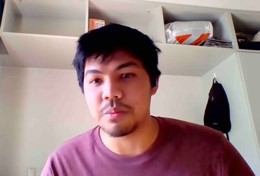
The excitement did not stop there. It continued to Day 2 indeed. The session began by sporadic questions and answers that the participants had written on the Mural platform before the session started. There were many interesting questions from the participants, but the most resonating one, personally speaking, was a question about whether recycling or iterating on old/existing ideas is a good thing to do. This is a common practice in design, thus answered the question with a simple yes, that recycling an old idea is a good thing to do as it provides an avenue for inspiration to come to light. David also mentioned “competitive landscape” work in which one might look at closely at every related idea in the past to recognize new opportunities but later add some originalities of oneself.
Next, the session was taken over by Scott to continue the Day-1 activity on drawing people. In Day 2, Scott showed us the simple practice of drawing things by introducing two common shapes: circle and square. Scott taught us how most things can be drawn using circle and square by extending it into 3D (i. e. cylinder and cube), such as windows, buildings, planets, and so on, and adding contrasting lines to show emphasis. As what had been explained in the opening of the workshop on Day 1, drawing is quite an important activity in design thinking as it lets one to materialize an abstract concept (an idea) into a visualization.
After that, we discuss a bit about our last week’s task on practicing noticing. Scott showed us some techniques on synthesizing the observations. We tried three common synthesis methods: typologies, spectrum mapping, and opportunity statements. The practice encouraged us to give meaning to our noticing practice as it was now showing recognizable and interesting patterns.
Lastly, before the session of Day 2 was closed, David came on to the stage to deliver the material on radical ideation, a concept that was very central in design thinking practice. The concept makes distinction between generative and selective ideation, which are something that I have been confused about. It explains the flow of forming an idea from scratch: that creating ideas should start with generating lots of quality ideas and then focusing on several that are worth pursued. Some steps on how to ideate, such as mind mapping, body storming, brainstorming, and crowdsourcing were explained and practiced within our groups in the workshop.
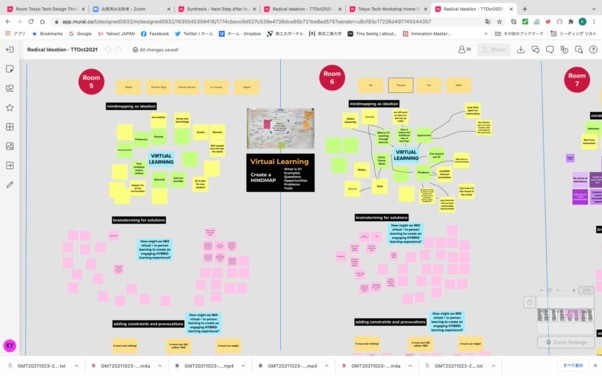
The concept was very simple yet quite hard to do without sufficient practice, especially by most of the engineering/science major students, as it is uncommon for engineering/science students to take on problems with multiple solutions.
And thus, concluding the Day-2.
<Day 3>
Report by Igor Segrovets, Department of Mechanical Engineering, M1
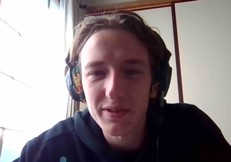
Warmed up after the Saturday ,full of discussions about our field work, and anticipating what finale might await us for this 3-day Design Thinking journey, the thirty six students began their last day of the course. For some this signaled a welcome release from the early starts, for others it meant that today was the morning after Halloween and we would get to see David, Thomas and Scott in spooky disguises.


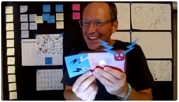
David Janka, Thomas Both and Scott Witthoft in their spookiest Halloween day disguises.
Our course continued in its previous fashion. Fast paced exercises to stretch the limits of our imagination, sandwiched between mini-lectures about principles of design after which we would be plunged into group work where we could see how it feels to exercise our Design Thinking; all this smothered with a mouth-watering “visual communication fundamentals” taught by Scott. If this course were a literal sandwich maybe it would be called the “Stanford D-School Club Special”. Having said this everyday of this course was truly different to the last so let’s see what was on the menu of Day 3: Design Thinking for Your Creative Practice.
The request for Day 3 was to to prepare various crafting materials at our work space. Straight away we put them to good use, making spooky disguises for our phones.
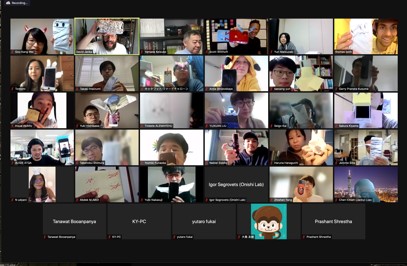
Spooky Halloween phone costumes, warm up activity
How fun is that? The warm-up activities never failed to lift the our spirits and engage us with the work that was ahead. Today at the core focused about “framing and re-framing problems”. In the first mini-discussion we were introduced to Doug Dietz an industrial designer who tasked himself with changing the way sick children experience the MRI medical procedure (Magnetic Resonance Imaging). He re-imagined the MRI machine as a kind of theme-park attraction, sure to capture the children’s imaginations and distract them from an otherwise scary medical procedure, but this was not an idea Doug took lightly. Doug went through a long design process to come to this idea and its final execution. Based on this example we were introduced to two key topics, (1) Prototyping and (2) Brainstorming and related techniques for re-framing problems.

Doug Dietz design process
What does prototyping mean to a designer? If you’re from an engineering/science background like me you might answer that a prototype is something that is to be later refined into the finished product. But what I learned from David, Thomas and Scott is that in design prototyping is a form of idea exploration or a way to visualize your thinking. Prototyping is a way to learn. What’s more is that through the exercises we performed it became evidently clear that creativity builds on limitations, and by grounding our imaginations to the limited crafting materials before us we were able to expand our awareness of the problem. In our last activity we were paired with another student to consider how might a family of two children with important dietary requirements could handle a power outage caused by a natural disaster. The design prompt was open-ended. Would you design a product, a service or a policy recommendation? Which framing of the problem would you and your partner decide on? After the initial discussion we were to build a prototype from our limited materials at hand. We exercised remote work acrobatics to each assemble complimentary halves of a prototype of our envisioned design.
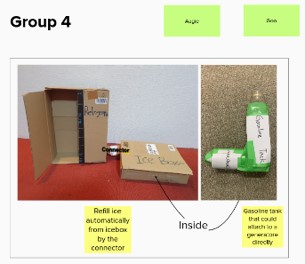
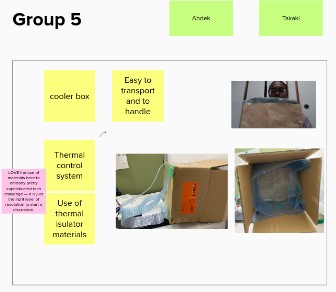
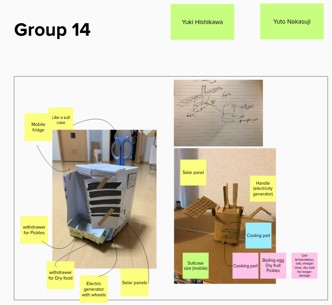
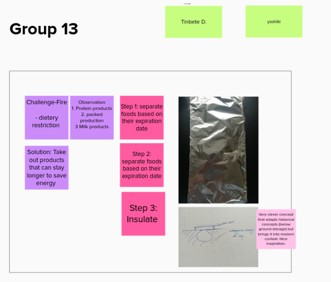
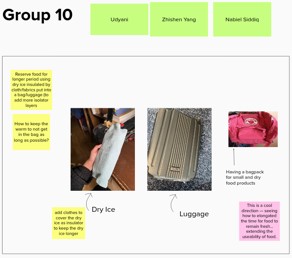
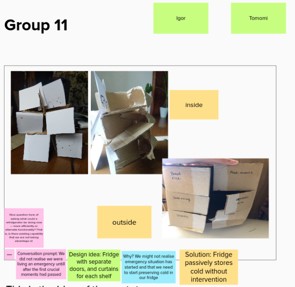
Selection of zoom collaborated prototypes from last design activity.
The second theme of the day was techniques for re-framing problems, although we were introduced to many I would like to focus on just one. This technique I feel was received well by the students. Many reflected later on its usefulness to their own life and studies, and it is also the one thing that I feel I would share with someone if they asked what I learnt at Design Thinking for Your Creative Practice. This technique is called Why/How laddering. At first you begin with one problem statement answering Why as you go up and answering How as you go down. As you go deeper into the problem, branches appear and you discover deeper relationships between issues. What I love about this simple technique is that it allows you to understand the abstract (going up with Why) and practical (going down with How) facets of a problem while accounting for their inter-relationships with arrows and branches.
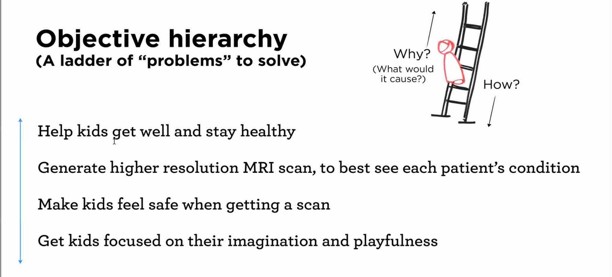
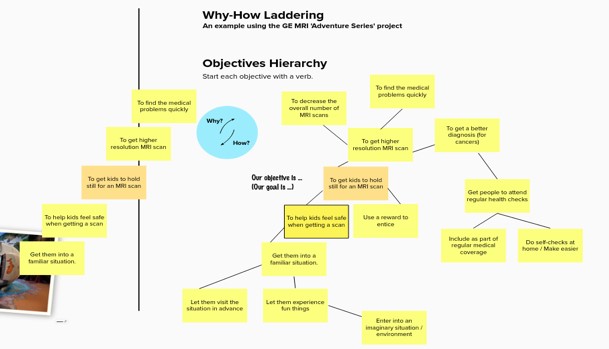
Example of why – how laddering, based on the MRI example mentioned previously
(Top: ) at first ideas are simple,
(Bottom: ) but as you go deeper into the problem, branches appear and you discover deeper relationships between issues.
To close of this reflection on Day 3 I would like to say that this was a really unique learning opportunity that I could recommend to anyone. However, I think the whole class can say it better than I can on my own. Please check out our mural board from the end of the last day, each box contains what students would say to their friend before they would attend this course themselves.
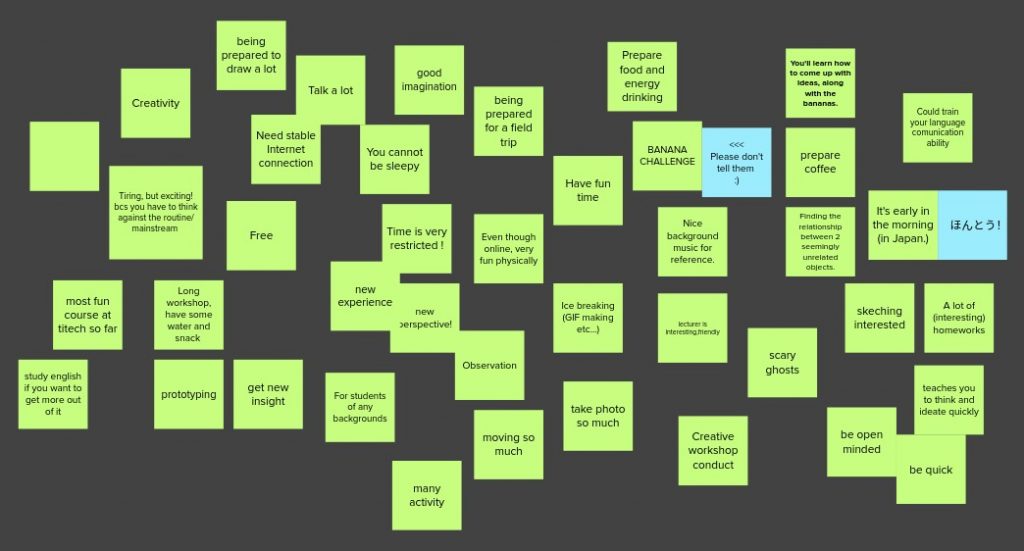
Each box contains what students would say to their friends before they would attend this course themselves.
(Reported by Tinbete Daniel Alemayehu, Nabiel Luthfi Siddiq and Igor Segrovets)


